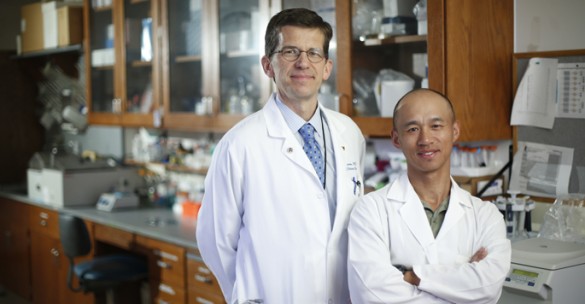
Vanderbilt-Ingram Cancer Center investigators have identified the mechanisms used by a gene and its binding protein to drive tumor growth in several forms of cancer, including non-small cell lung cancer.
In a report published online recently in the Proceedings of the National Academy of Sciences (PNAS), first author Jun Qian, Ph.D., lead investigator Pierre Massion, M.D., and colleagues report that the RNA binding protein FXRI is a regulator of tumor progression, and when it is overexpressed it is predictive of poor survival in many types of cancer.
The gene for this protein is a family member of the Fragile X mental retardation 1 (FMR1) gene. There has been much research on the Fragile X gene but not much was known about FXR1.
“One of the central hypotheses tested in our study is that in cancer there is no one driver gene in an amplicon — a piece of a chromosome that harbors multiple copies of the same segment of DNA — but several oncogenes that work together to drive the cancer,” Massion said.
“FXR1 is a binding protein and it binds to either RNA or a protein complex that it regulates closely,” said Qian.
In cell lines, animal models and non-small cell lung cancer tissue samples, the investigators found that FXR1 engages with two partner oncogenes, PRKC1 and ECT2, to promote tumor progression. The finding provides additional evidence that tumor progression is the result of multiple oncogenes working in concert.
Massion’s research laboratory specializes in lung cancer, a disease with a poor five-year survival rate.
“In greater than half of the cases, we still we don’t have a known driver mutation detected,” said Qian.
Identifying a driver mutation and the way in which it operates is a crucial first step in understanding how a type of cancer grows and evades treatment. The study suggests that FXR1 may be a novel target for potential new cancer therapies.
“I think one of the exciting things about our study is we present not only evidence about this potential oncogene in lung cancer, but we are also finding a role for it in breast, head and neck and ovarian cancer,” Qian said. “There must be a mechanistic link between these cancers, so I think that is very relevant to cancer biology and an exciting field for future investigation.”
Meharry Medical College and Veterans Affairs Tennessee Valley Healthcare Systems also contributed to the study. Other investigators include Mohamed Hassanein, Ph.D., Megan Hoek-sema, Bradford Harris, Yong Zou, M.S., Heidi Chen, Ph.D., Pengcheng Lu, M.D., Rosana Eisenberg, M.D., Jing Wang, Ph.D., Allan Espinosa, M.D., Xiangming Ji, Ph.D., Fredrick Harris, Ph.D., and S.M. Jamshedur Rahman, Ph.D.
The study was supported by funding from the National Cancer Institute, a division of the National Institutes of Health (R01 CA102353, CA090949), and the Department of Defense (CDMRP LC090615P3).














